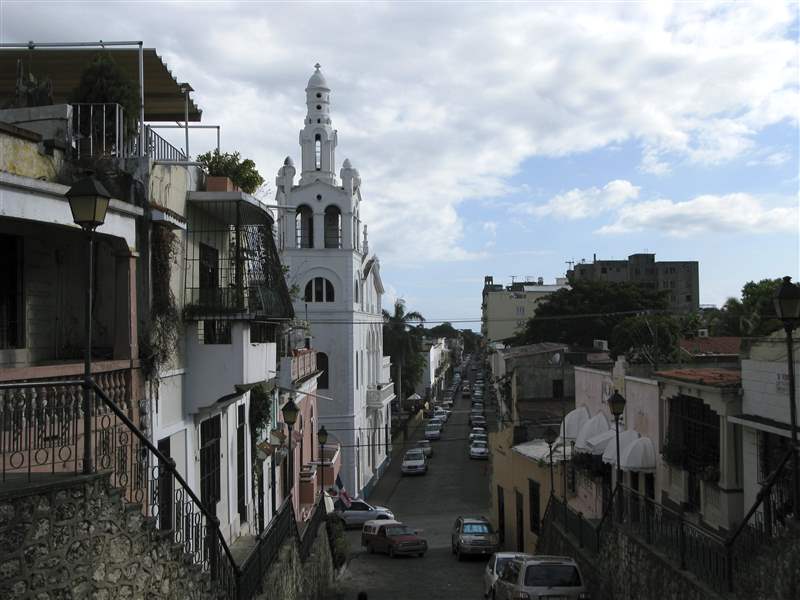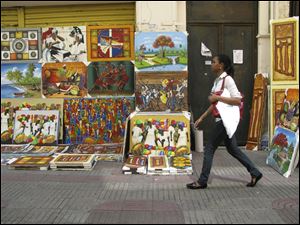
Sandless in the Caribbean: Dig into history instead
Long weekend in Santo Domingo provides fascinating view of region’s families and culture
11/24/2013
Much of Santo Domingo's urban and historical richness lives in the Zona Colonial area of the city.
CHICAGO TRIBUNE

Much of Santo Domingo's urban and historical richness lives in the Zona Colonial area of the city.
SANTO DOMINGO, Dominican Republic — During four days in the historic heart of the Dominican capital, I saw men gather every afternoon in the central square to play dominoes, usually ringed by crowds of onlookers.
I saw four women park beside the rolling Caribbean Sea on a Friday afternoon to crack bottles of Presidente beer and play ground-shaking music. In a park where artisans sold their wares, I sipped rum and watched men with long beards pound drums, blow horns, and sing in a festive circle.
What I didn’t see in those four days was a single sunbather. That’s right: a long weekend in the Caribbean without a beach, a bathing suit, or the words “all inclusive.” That’s heresy for some perhaps but also a fascinating and decidedly “normal” view of the other Caribbean — the cities, families, culture, and history.
Among the liveliest intersections of such richness is the Dominican capital, a city of 3 million that stakes a claim as the nexus of the New World. Christopher Columbus landed on the island’s north coast in 1492, and his family stayed for generations.
Much of Santo Domingo’s urban and historical richness lives in the Zona Colonial, which is many things at once: It is a living-history UNESCO World Heritage site, a heavily touristed tapestry of parks, shops, restaurants, and street merchants, and it is a neighborhood that people call home. Wander its side streets, and Santo Domingo becomes a world of open doors and windows into the lives of the people there: women cooking, children playing. But with ample hotels, restaurants, and historical sites, it is well equipped for tourism without managing to ever feel too touristy.
That’s especially true late on weekend nights, when Dominican youths flood the area to hang out in darkened parks with an easy joy; everyone looks good, but no one is too dressed up. Restaurants and art galleries stay open late, and music echoes through the cobblestone streets long into the night.
The city also comes with plenty of hustle. On Calle El Conde, the brick pedestrian walkway just west of Zona Colonial, seemingly everything is for sale: clothes, art, shoes, baseball caps, and ancient books and magazines (the May, 1979, National Geographic, for example). Offers of taxi and carriage rides are nearly constant, and when opting for one, be sure to negotiate a price in advance. (My carriage driver cheerfully asked for $20 for a 200-yard ride; I negotiated down to $8.)
There will be just as many offers of tour guides to lead a visitor through the Zona Colonial, and brimming as Santo Domingo is with history, it’s worth it.

Calle El Conde is a pedestrian walkway where seemingly everything is for sale, including art, in Santo Domingo, Dominican Republic.
On my third day in town — days I spent walking, eating, visiting museums, and lounging in parks — I chose as my guide Elias, a man in his 40s with a collared shirt and neatly brushed hair. I agreed to his price of about $40 (most guides can be talked down to about $30) and was told the tour would last as long as I wished.
Unfortunately for Elias, it became longer than the typical two hours, not just because I wanted my money’s worth but because, in the cradle of Western Hemispheric history, it seemed a waste not to revel in every worn stone structure.
Zona Colonial stops included Fortaleza Ozama, a Spanish-built 16th-century castle that is the oldest European-built fort in the Americas; the house of Diego Columbus, Christopher’s son, which has been restored and remains a popular attraction; the oldest hospital in the New World (now possibly the most fascinating pile of ruins in the New World), and the cathedral in the heart of the Zona Colonial’s square, reputed to be the oldest active cathedral in the Americas. On an 80-degree winter day, it seemed to have more tourists seeking cover from the sun than it did adherents.
Mind you, all of this sits within about a mile radius.
Back at my hotel, Casa Naemie, a wonderfully cheap and tidy neighborhood spot run by Haitian immigrants, I wandered to the roof to gaze out on the night. A rain cloud was pouring over the Caribbean, but things in town were perfectly dry as the sky turned a deep pinkish-red.
Next door was an apartment building, and two of its residents — a shirtless man and a woman in a tank top, both of whom appeared to be in their 20s — emerged with a radio, bobbing their heads to a percussion-heavy soundtrack. We caught eyes, traded smiles, and nodded hello. At moments like that, so far from the beach, I gladly reminded myself that I was in the Caribbean.
IF YOU GO:
GETTING THERE: The primary airport in Santo Domingo is Las Americas, and the major airlines, including American, United, and Delta, fly there nonstop from cities that include Atlanta, New York, and Miami.
STAY: There is an ample range of affordable accommodations in the Zona Colonial, including Hostal Nicolas de Ovando (accorhotels.com, from about $160 per night), which features a lovely pool; the historic and renovated Hotel Palacio (hotel-palacio.com, from $90 per night); and, my favorite, the clean and cozy Casa Naemie (casanaemie.com, an incredible deal starting at $35 per night).
EAT: Meson D’Bari (Calle Hostos 302, tinyurl.com/mesondebari) has high-concept Caribbean food, from crab empanadas to stewed goat; it’s popular with locals and tourists. D’Comer Colonial (Corner of Calle Isabel La Catolica and Calle Arzobispo Portes) is open only for lunch but served some of the best, freshest, and heartiest food I ate in Santo Domingo. The beef, chicken, rice, potatoes, and remarkable sauces seemed like something I’d find in someone’s home. The place for those who eschew meat is Crudo (Calle Arzobispo Portes 152), a vegetarian restaurant that still relies on classic Dominican (and foreign) spices and flavors.
DO: In the Zona Colonial, the best thing to do is walk. Though Dominicans themselves warned me about muggings and crime, I never felt unsafe in and around the area. There is more history than most people will want to see, but that doesn’t mean you shouldn’t investigate. Musts include the Catedral Primada de America in Parque Colon, which is the oldest operating cathedral in the Americas, and Museo Alcazar de Colon, which is the former home of Christopher Columbus’ son, Diego.
The Dominican baseball season runs from mid-October to mid-January, and Santo Domingo is home to two teams that share the 16,500-seat Estadio Quisqueya, a 15-minute cab ride from the Zona Colonial. Seats behind home plate cost about $10.
If you want to tack on a beach vacation while visiting Santo Domingo but don’t want to travel far, do as the locals do and head one hour east to Juan Dolio, where there are several all-inclusive resorts.
Because the resorts often cater to locals as much as (if not more than) foreigners, the prices are quite reasonable.
MORE INFORMATION: santodomingotourism.com, zonacolonial.com